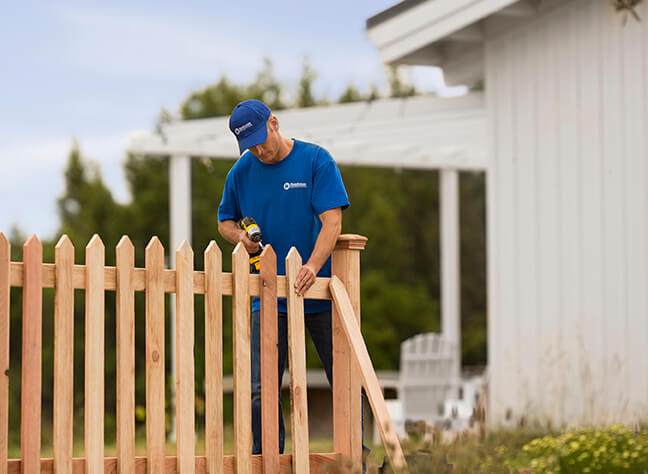Even the most durable fences can suffer damage from storms, animals, or simple aging. A damaged fence can leave your yard vulnerable to intruders and detract from the overall appearance of your home.
Before repairing any fence problem, it’s important to diagnose the cause. Whether it’s something as simple as a rotted post or something more complex like a bent metal post, the first step is to dig around the base.
Whether they’re wooden or metal, fences are prone to damage from the elements. Wooden fences, in particular, are prone to warping, rot, and insect infestation. However, regular maintenance and preventive repairs can keep your fence in good shape. If you notice any issues with your fence, you should address them right away before the problem escalates.
If your fence has a sagging rail, it’s important to identify the cause of the problem. It may be a sign of a faulty foundation or a loose post. If the foundation is weakened, it’s important to shore it up with concrete. It’s also a good idea to install additional posts in the area to provide support.
Sagging rails can be repaired by using chain-link fence ties to connect the top of the fence to the bottom. Depending on the size of your fence, you might need to use several wires to make this connection. You can buy these ties at most hardware stores. If you’re planning to do the repair yourself, you should first locate the damaged section and the undamaged portion of the fabric. Then, use lineman’s pliers to untwist the wire ties and free the fabric from the fence.
Then, use the same pliers to straighten out the bent portion of the wire. If the wire is rusty or severely damaged, you should replace it with new wire.
Fence gate repairs can be tricky, and they’re often the result of misjudged materials or poor workmanship from the original builder. However, you can fix a sagging gate by adding tension to one side of the gate with a turnbuckle and cable kit. You can purchase these kits online or at most hardware stores. The kits include two to four corner braces, a turnbuckle, cable, and fittings. You can also add a diagonal brace to the gate frame to increase its stability. This will relieve pressure on the sagging side of the gate and prevent it from sagging in the future.
Broken posts
Many fence repair projects involve fixing broken posts. However, it is important to assess the severity of the damage before deciding how to approach the task at hand. For instance, if a post has simply shifted out of alignment and is not rotting or otherwise damaged, you may only need to reset it. On the other hand, if a post has broken off completely or is severely weakened by wood rot, you will likely need to replace it.
Before beginning any work, it’s a good idea to make sure that you have the proper tools and supplies to complete the job. Having these items nearby will make the job much easier and less stressful. Some tools to have include hammers, wrenches, a drill, a shovel, and safety equipment such as goggles and gloves.
Once you have all the necessary tools, start by excavating around the post foundation to expose the concrete base and determine its condition. If the concrete is in poor shape, it is a good idea to use a grinder with a masonry blade attachment to break it up and remove it. This method is especially useful for older concrete posts, which are typically made from a weaker and drier mix of cement. You should aim to retain the first few inches of soil in order to dress the top of the hole once the repair is complete.
If the post has already broken off at ground level, it’s important to shore up the area to prevent a domino effect whereby the loose post causes further damage to other posts and panels in the vicinity. This can be done using a variety of methods, but one popular option is to use wood putty. This product is available in various forms, but it should be clear that this is not a permanent solution and will likely require further attention from a professional.
Similarly, if the post is rotted but not yet broken off at ground level, you can try to use the Wood Post Puller method to remove the existing concrete footing and wood post stump so that a replacement can be set in place. Once the new post is in place, it should be treated against rot and water damage to avoid a repeat of the problem.
Damaged panels
Even the best-built fences can experience environmental damage over time. Weather impacts like high winds and humidity can weaken the materials used to build a fence and cause structural problems. These problems can include a leaning gate or loose panels. While these issues usually indicate the need for a repair or replacement, they don’t necessarily require replacing the entire fence.
Before beginning a DIY fence repair, it’s important to assess the damage and determine whether it’s worth repairing or not. It’s essential to decide if the damage is acute, like a rust spot that can be repaired with paint, or chronic, such as wood rot. It’s also important to consider the size of the damage and how long it will take to repair it.
Typically, repairing cracks and holes is a simple process for most types of fencing materials. If you have a vinyl fence, start by using an alcohol-soaked cloth to wipe away any excess debris. Then, apply a layer of auto body filler to the hole and allow it to dry. Once the filler dries, you can use a knife to smooth it and make sure that the repair blends in with the rest of the fence.
If you have a damaged panel that can’t be repaired, it may be necessary to replace it entirely. It’s important to choose a material that is suited to your climate and can withstand the elements. If you have a steel or iron fence in an area that experiences a lot of humidity, it’s a good idea to choose a coating that is moisture-resistant.
It’s a good idea to have a friend assist you in installing a new panel if you can’t handle the weight by yourself. Ensure that the panel is level before screwing it into place. If the panel has a metal base, you should attach a pair of metal clips to the post to hold it in place.
Replacing a board or slat is a simple and inexpensive process for most types of fences. The price of a new panel will depend on the material type, the extent of damage, and the height of the fence.
Bent rails
Chain link fences get a bad rap compared to charming white pickets and gothic wrought iron, but they are practical and incredibly durable. They also tend to be less expensive than many other fencing options, making them a popular choice for homeowners and businesses. Like anything, however, they can break down and need repair, especially when a storm or critters get to them.
Bent rails can be a serious problem that jeopardizes the structural integrity of the whole fence and leads to costly replacement. Fixing a single bend is relatively easy, but multiple ones may require the replacement of the entire fence or sections. In such cases, you will likely want to use wire ties to connect the new sections of fence to the existing fabric using linesman’s pliers.
To begin, locate the area of bent rail and straighten it out as much as possible by finding the hooked end of the wire and untwisting it with lineman’s pliers. Then, find two points of fabric on either side of the damage and use a similar technique to remove the wires holding them in place. Then, find a replacement piece of pipe and cut it to length with your reciprocating saw. Make sure the new section is a slightly different length than the old one to prevent it from twisting under its own weight when it’s installed.
After cutting the new rail, loosen a rail end (the cup-like fitting that holds the rail to the post) with an adjustable wrench and lower it until there is enough space to align the larger end of the replacement rail with the sleeve on the existing one. Then, slide the replacement rail’s tapered end into the existing one. Finally, slide the rail coupling over the other end of the replacement rail to attach the two and tighten.
If your gate is broken, you can easily replace it at a fraction of the cost of replacing your fence. To start, disconnect the hinge strap from the gate by sliding a bolt through the hole and tightening it with a socket wrench. Slide the gate hinge away from the fence and set it aside. Locate the latch plate and the hinge pin inside the gate frame, and then use a screwdriver to remove the nut from the gate post and set it aside as well.

